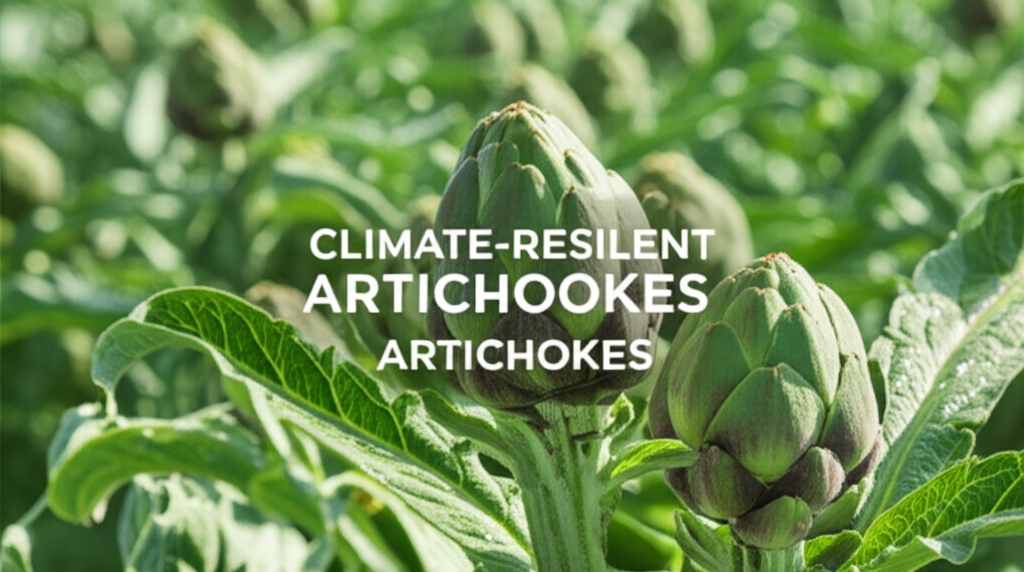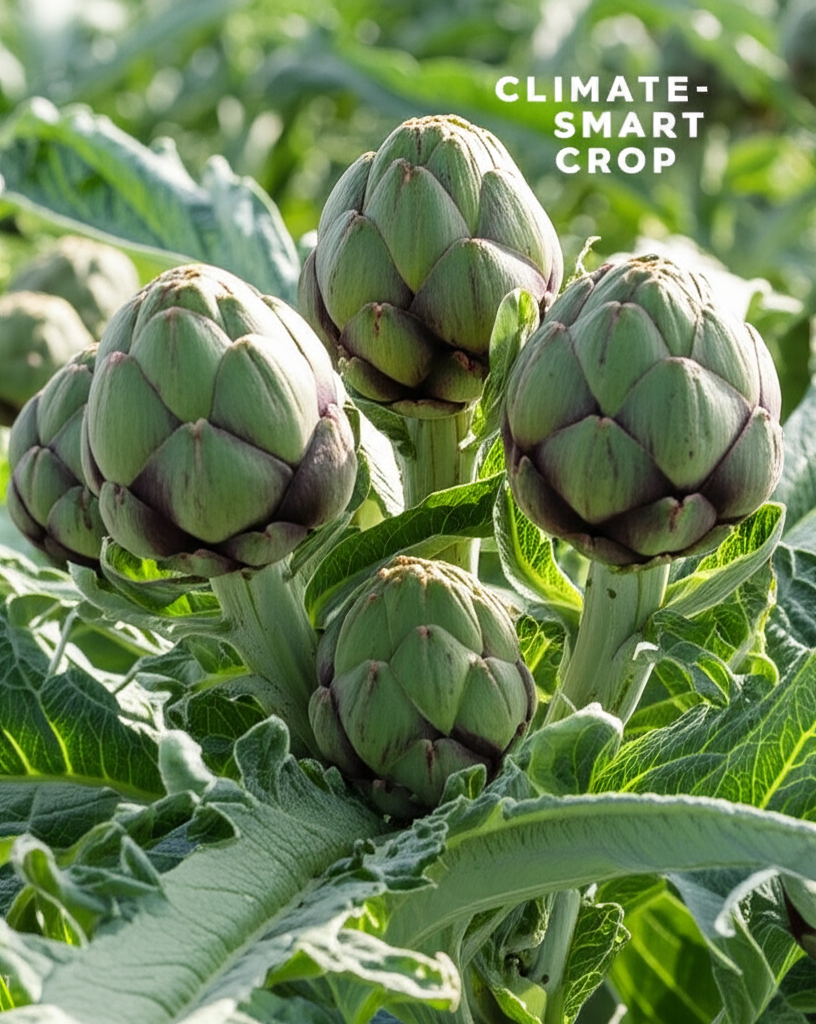Introduction: A Culinary Treasure Facing Climate Challenges
The globe artichoke (Cynara cardunculus var. scolymus) is a remarkable vegetable, prized for its unique flavor and culinary versatility. Beyond its gastronomic appeal, this member of the thistle family is increasingly recognized for its potential as a climate-resilient crop. As our planet faces the unpredictable shifts of climate change, including fluctuating temperatures, altered rainfall patterns, and increased pest pressures, the need for adaptable and robust food sources becomes paramount. Globe artichokes, with their deep root systems, natural drought tolerance, and relative resistance to common pests, offer a compelling answer to this growing challenge. This article will delve into the characteristics that make globe artichokes so well-suited to changing environmental conditions, explore their cultivation benefits, and highlight their potential to contribute to a more sustainable and resilient food system.
Understanding Globe Artichokes: Botany and Adaptability

Globe artichokes are perennial herbaceous plants, typically growing to heights of 3 to 5 feet (approximately 1 to 1.5 meters) and spreading to a similar width. They are native to the Mediterranean region, an area known for its diverse climates, which likely contributed to their evolutionary adaptability. The plant is primarily grown for its edible flower bud, which is harvested before the flower opens. The fleshy base of the bracts and the heart are the edible portions.
Several key botanical features contribute to the globe artichoke’s resilience:
- Deep Taproot System: Artichokes develop a substantial taproot that can penetrate deep into the soil, allowing them to access moisture even during dry periods. This makes them significantly more drought-tolerant than many other common vegetable crops.
- Perennial Nature: As perennials, artichokes establish strong root systems over time, which helps them withstand environmental stresses. They don’t need to be replanted annually, reducing labor and soil disturbance.
- Natural Defense Mechanisms: The spiny leaves and thistle-like appearance of the artichoke plant act as a deterrent to many common garden pests and grazing animals.
- Tolerance to Varied Soil Conditions: While they prefer well-drained, fertile soil, artichokes can tolerate a range of soil types, including those that might be less ideal for more sensitive crops.
Key Facts About Globe Artichokes
Here’s a quick overview of essential information regarding globe artichoke cultivation:
| Fact | Details |
|---|---|
| Scientific Name | Cynara cardunculus var. scolymus |
| Plant Type | Perennial herbaceous plant |
| Origin | Mediterranean region |
| Edible Part | Flower bud (before opening) |
| Ideal Climate | Mild, temperate climates; can tolerate some heat and mild frost once established. |
| Soil Preference | Well-drained, fertile loam with good organic matter content. |
| Sunlight Requirement | Full sun (at least 6-8 hours per day) |
| Watering Needs | Moderate, especially during dry spells; deep watering is beneficial. |
| Pest & Disease Resistance | Generally good, with some susceptibility to aphids and slugs. |
Globe Artichokes in a Changing Climate: Advantages
The characteristics of globe artichokes translate directly into significant advantages for growers facing the challenges of a changing climate.
Drought Tolerance
One of the most pressing issues in a warming world is the increasing frequency and intensity of droughts. Globe artichokes, with their deep root systems, are naturally equipped to handle periods of reduced rainfall. While they perform best with consistent moisture, they can often survive and even produce a crop in conditions that would devastate less resilient plants. This makes them an attractive option for regions experiencing water scarcity or unpredictable rainfall. Their ability to continue drawing moisture from deeper soil layers allows them to maintain essential functions longer than shallow-rooted crops.
Temperature Fluctuations
Globe artichokes are generally considered a cool-season crop, preferring temperatures between 50-75°F (10-24°C). However, established plants exhibit a surprising tolerance to both mild frosts and moderate heat. Young plants are more susceptible to frost damage, but once established, they can often survive winter temperatures that would kill annual vegetables. In warmer climates, they may require some shade during the hottest part of the day to prevent stress and improve bud quality. Their ability to withstand some temperature variability without significant yield reduction contributes to their climate resilience.
Reduced Pest and Disease Pressure
While no plant is entirely immune to pests and diseases, globe artichokes possess natural defenses that can reduce the need for chemical interventions. Their spiky foliage can deter some common garden pests, and their robust nature makes them less susceptible to certain soil-borne diseases that can plague annual crops. This inherent resistance can lead to lower input farming practices, aligning with sustainable agriculture goals and reducing vulnerability to climate-induced pest outbreaks, which can be exacerbated by shifting weather patterns.
Soil Health and Carbon Sequestration
As perennial plants, globe artichokes contribute positively to soil health over the long term. Their extensive root systems help to improve soil structure, prevent erosion, and increase organic matter content. This enhanced soil health can lead to better water retention and nutrient cycling, further bolstering the plant’s resilience and contributing to carbon sequestration in the soil, a crucial element in mitigating climate change. Reduced tilling required for perennial crops also helps maintain soil structure and microbial communities.
Cultivation and Growing Practices
While globe artichokes are relatively hardy, adopting certain cultivation practices can further enhance their resilience and productivity.
Site Selection
Choosing the right location is crucial. Globe artichokes thrive in full sun, requiring at least 6-8 hours of direct sunlight daily. They prefer well-drained soil; waterlogged conditions can lead to root rot. Incorporating compost or well-rotted manure into the soil before planting will improve fertility and drainage.
Planting and Propagation
Artichokes can be grown from seeds, but they are more commonly propagated from root divisions or transplants. Starting from divisions or healthy transplants generally leads to faster establishment and earlier harvests. When planting, ensure adequate spacing, as the plants can become quite large.
Watering and Fertilizing
Consistent moisture is important, especially during establishment and during flowering. Deep watering encourages the development of their deep root system. While they are drought-tolerant once established, prolonged dry spells without any watering will impact yield. They are moderate feeders; a balanced fertilizer applied in early spring and again after the main harvest can support vigorous growth. Over-fertilizing with nitrogen can lead to excessive leafy growth at the expense of bud production.
Winter Protection and Pruning
In colder climates (USDA Hardiness Zones 7 and below), globe artichokes benefit from winter protection. This typically involves cutting the plants back after the first hard frost and covering the crowns with a thick layer of mulch (straw, shredded leaves, or compost). This protects the root system from freezing temperatures. In the spring, remove the mulch and cut away any dead foliage. Pruning also involves removing any damaged leaves and ensuring good air circulation. Some growers also prune to encourage a more concentrated harvest or to promote new growth for the following season.
Harvesting
Artichokes are ready to harvest when the bud is firm and plump, and the bracts are still tightly closed. Harvesting too late allows the flower to open, reducing the quality of the edible bud. Use a sharp knife to cut the stem about an inch or two below the bud. Regular harvesting encourages the plant to produce more buds.
Pros and Cons of Growing Globe Artichokes
Here’s a look at the advantages and disadvantages of cultivating globe artichokes, particularly in the context of changing climate conditions:
| Pros | Cons |
|---|---|
| Climate Resilience: Good drought tolerance and some frost/heat tolerance. | Space Requirement: Mature plants can take up significant garden space. |
| Perennial Nature: Reduces annual planting effort and soil disturbance. | Long Establishment Period: May take 1-2 years to produce a significant crop. |
| Natural Pest Resistance: Spiky foliage deters some pests. | Susceptibility to Certain Pests: Can be affected by aphids, slugs, and snails, especially young plants. |
| Soil Improvement: Deep root system improves soil structure and organic matter. | Winter Protection Needed in Colder Climates: Requires mulching and protection in zones below 7. |
| Nutritious and Versatile: High in fiber, antioxidants, and can be prepared in many ways. | Specific Growing Conditions: Prefers full sun and well-drained soil for optimal production. |
| Aesthetic Appeal: Attractive foliage and potential for large, showy flowers if buds are not harvested. | Can Tolerate Some Salinity: May offer a niche advantage in coastal areas with slightly saline soils, though extreme salinity is detrimental. |
Global Applications and Future Potential
The resilience of globe artichokes makes them a candidate for cultivation in a wider range of geographical areas than previously thought. As climate change forces agricultural systems to adapt, crops like the artichoke that can withstand less-than-ideal conditions will become increasingly valuable.
Diversifying Food Systems
Incorporating globe artichokes into diverse agricultural landscapes can enhance food security. Their ability to thrive in conditions that challenge more sensitive crops provides a buffer against crop failures due to extreme weather events. This diversification is crucial for building robust and resilient food systems capable of withstanding the shocks of climate change.
Economic Opportunities
For growers, the potential for a perennial crop that requires fewer inputs and has a relatively long harvest season can present economic advantages. The unique nature of the artichoke also lends itself to specialty markets and direct-to-consumer sales, where its culinary appeal and unique qualities are highly valued. As demand for sustainable and climate-friendly produce grows, globe artichokes could become a more significant cash crop.
Research and Development
Ongoing research into artichoke varieties that are even more tolerant to heat, drought, or specific pests could further expand their role in climate-resilient agriculture. Breeding programs focused on these traits will be essential in optimizing their potential for future growing conditions. Understanding the genetic basis for their resilience can also inform strategies for improving other crop varieties.
Conclusion: A Delicious Ally for a Changing Planet
Globe artichokes are more than just a culinary delight; they are a testament to nature’s ingenuity and a valuable asset in our quest for climate-resilient agriculture. Their deep root systems, inherent toughness, and adaptability position them as a crop capable of withstanding the environmental stresses brought about by a changing climate. By embracing and expanding the cultivation of globe artichokes, we can not only enjoy their unique flavors but also contribute to building more sustainable, secure, and resilient food systems for the future. Their ability to thrive with fewer resources and offer consistent yields in varied conditions makes them a truly promising plant for a world in transition.


